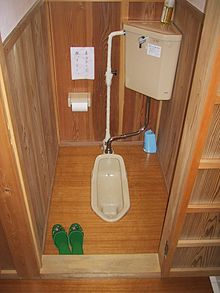Squat toilet
A squat toilet (coll. Also squat toilet , sometimes standing toilet ) is a toilet that requires a squat for defecation . There are several versions of a squat toilet:
- Variation in which the user looks towards the entrance of the toilet. This type of squat toilet is common throughout the Islamic world, particularly in Central Asia , Africa , Arabia , Southeast Asia , China and Turkey , including in private homes. It is also common in India , where it is called IWC (Indian Toilet) to distinguish it from the European EWC . In Europe, the Mediterranean squat toilet in public toilets in Southern Europe , in France and in the former Soviet Union and in South East Europe to find, in Switzerland, she was in the French-speaking Switzerland and Ticino to be found. In Arabia, this toilet is usually equipped with a side water inlet, but at least with a water jug or a water bucket. This water is used to clean the genitals and - in simple toilets - also for rinsing. The feces are collected in an underground holding tank, periodically pumped out and composted. Therefore, no toilet paper should get down the drain in such toilets. There are usually paper bins available for used toilet paper.
- Japanese squat toilets have a different shape and the user looks towards the semicircular raised part of the toilet.
advantages
- Diverse health benefits due to the anatomically sensible stretching of the last section of the large intestine during bowel movements.
- There is no contact between the user's skin and potentially dirty surfaces, such as the toilet seat .
- Squat toilets are easier to clean and maintain, and are less likely to be the target of vandalism.
- Due to the simple design, squat toilets are cheaper to buy.
disadvantage
- People who cannot squat deep enough due to insufficient mobility cannot find a relaxed posture and have to defecate in a “skier's squat” or half-standing.
- If you have problems with your balance, you can slip and fall. With the Japanese variant, this risk is significantly lower, since the inlet pipe can be used to hold on.
- People with knee osteoarthritis have particular difficulties using the toilet.
- People who are inexperienced in using it often make the toilet dirty.
- People with physical disabilities - such as wheelchair users or people with walking aids - cannot use the toilet.
- Due to the uncomfortable posture, they are less inviting to linger, which means that there is a risk that the user will try to accelerate the bowel movement by pressing too hard, which can result in damage to health .
- In the case of diarrhea as well as various urination disorders , it can be disadvantageous to have to bend down deeply.
- In addition, diarrhea can lead to soiling of clothing (shoes, trousers / dress, underwear) and the toilet itself with splashing feces, even for "experienced" users.
Others
When David Černý symbolized Bulgaria for his work of art “ Entropa ” with a collage of Turkish standing toilets, the Bulgarian government insisted on removing this depiction.
Web links
Commons : Squat Toilet - Album with pictures, videos and audio files
- Health benefits of the standing toilet: English original / German translation


